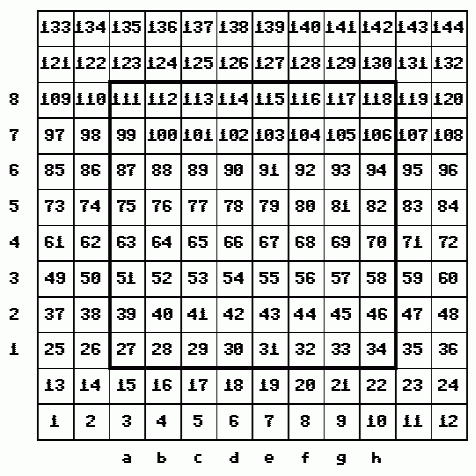La solucion esta en CASA, y llama la antencion la estacion de tren: Llanfairpwllgwyngyllgogerychwyrndrobwllllantysiliogogogoch.
Spider Legs
Hace 1 semana.
(talento en video juegos)
UPDATE: ahora en version cartridge: http://manillismo.blogspot.com/2024/02/new-adventures-of-laura-cartridge.html
Mas detalles del libro de ajedrez de Data Becker: http://manillismo.blogspot.com/2018/09/ajedrez-por-ordenador.html
https://www.c64-wiki.de/wiki/Das_grosse_Computerschachbuch
 Diagram of the one-dimensional embedded board representation
Diagram of the one-dimensional embedded board representation 100 REM DAMENZUEGE NACH RECHTS OBEN
110 REM STANDORT IST S
120 Z=S: REM ZIELFELD
130 Z=Z+13: REM 13 IST NUN DIE SCHRITTWEITE
140 IF BR(Z)=14 THEN GOTO 170: REM UEBER RAND GELAUFEN ?
149 REM FREIES FELD?
150 IF BR(Z)=7 THEN "ZUG EINTRAGEN": GOTO 130
160 IF BR(Z) "IST GEGNERISCHE FIGUR" THEN SCHLAGZUG EINTRAGEN"
170 REM FERTIG1. How did chess come to the machine - history of computer chess .......................... 5 1.1 The first chess machines ............................... 6 1.2 Theorists ............................................... 9 1.3 The era of mainframes ................................. 17 1.4 Super Giant ......... .................................... 36 1.5 Uprising of the Microphones ..................................... 46 2. How Does the Computer Learn to Win ? Theory of strategy games ........................... 57 2.1 The presentation of the game .................................... 58 2.2 The rules of the game ......................................... 60 2.3 The decision-making process .............................. 64 3. Always up to date - search strategy and game tree ...... ..................... 85 3.1 Programming - Art and Technology ....................... 85 3.1.1 Program development ..................................... 85 3.1.2 Program Organization .................................... 86 3.1.3 The Stack ............................................. .. 87 3.1.4 Special features of BASIC ................................ 97 3.2 Structure of a chess program ........................... 99 3.2.1 The components ........................................ 99 3.2.2 Dependencies ..................................... 100 3.2.3 The basic concept ....................................... 101 3.3 The train generator ....................................... 103 3.3.1 Two-dimensional board presentation ...................... 104 3.3.2 One-Dimensional Compact Board Presentation ............. 106 3.3.3 One-dimensional Embedded Board Presentation .......... 107 3.3.4 The train generator as a whole ............................. 108 3.4 Searching and Deciding ................................. 109 3.4.1 The evaluation function ................................. 110 3.4.2 The Minimax Search ........................................... 112 3.4.3 The Alpha Beta Algorithm ............................. 120 3.4.4 The search for peace ....................................... 129 3.4.5 Chess, dull, stalemate and the search for peace ................... 139 3.4.6 Variable search depth ..................................... 149 3.4.7 The iterative search .................................... 152 3.4.8 Train selection and train sorting ......................... 164 3.5 The position evaluation ................................. 170 3.5.1 Introduction ............................................. 170 3.5.2 The material evaluation .................................. 175 3.5.3 The positional evaluation ............................. 189 3.6 Auxiliary routines ............ ................................... 261 3.7 Input / Output Routines ............ ........................ 263 3.8 The lot management ................................... 264 3.8.1 The position entry ................................... 265 3.8.2 The party loop ..................................... 267 4. The program ... ........................................ 269 4.1 The Data Structures and Modules at a Glance .. .......... 270 4.2 The basic data structures ...................... 272 4.2.1 Positional presentation ................................... 272 4.2.2 Train presentation ......................................... 281 4.2.3 The train lists ............ ............................. 282 4.3 Declarations. ......................................... 284 4.4 Initializing and Reading the Partial Position .. ........ 287 4.5 The train generator ...................................... .. 292 4.6 The evaluation function .................................... 300 4.6.1 The control of the sequence ............................. 301 4.6.2 The position analysis ................................... 306 4.6.3 The peasant movement ..................................... 308 4.6.4 The figure evaluation ................................... 312 4.6.5 The royal evaluation .................................... 316 4.6.6 The Matt Routines ........................................... 322 4.7. Deepening Trains and the Stack .................. 324 4.8 General Auxiliary Routines ..................... .......... 330 4.9 The search and specific auxiliary routines ................ 333 4.9.1 The Auxiliary Routines ...................................... 334 4.9.2 The search ............................................. 340 4.10 Batching and input ....................... 346 4.11 Output routines ........ ....... ......................... 351 4.12 Variable reference list .................... ............ 352 5. How to play chess against computers .................... 359 5.1 Test your chess program .......................... 360 5.1.1 Which strategy? ..................................... 361 5.1.2 Initiative test .......................................... 364 5.1.3 Opening Library ................................... 367 5.l.4 Positional strengths and weaknesses ..................... 373 5.1.5 Compute Depth ............................................. 378 5.1.6 Permanent Brain ........................................ 384 5.1.7 King Tower Endgame .................................... 386 5.1.8 Subconvertions ..................................... 389 5.2 How to Beat a Chess Program - 7 golden rules to win .......................... 390 5.2.1 Unusual openings .............................. 393 5.2.2 Playing the Gambit ......................................... 397 5.2.3 No tactical complications - provoke exchange ................................. 404 5.2.4 Set traps ......................................... 406 5.2.5 If possible, aim for the endgame - Handle the final game in a plan .......................... 416 5.2.6 What do you have from it? ................................... 421 6. Appendix ........... ..................................... 423 6.1 List of mentioned programs and chess computer ..................................... 423 6.2 Bibliography ................................... 424 6.3 Complete Listing: DEMOSCHACH ......................... 428
Publicaron scan del manual para Atari de AdventureWriter (quill) en atarimania.
Es un muy buen aporte al haber solo versiones de c64 y a2 en la red.
http://www.atarimania.com/game-atari-400-800-xl-xe-adventurewriter_126.html
https://archive.org/details/AdventureWriter_201810
